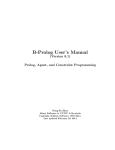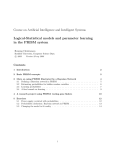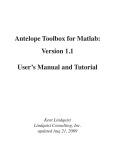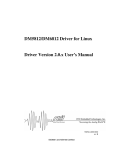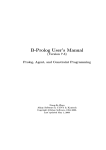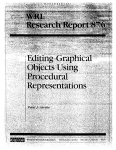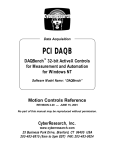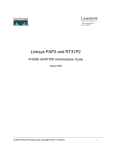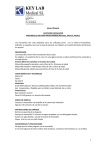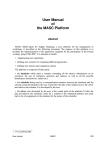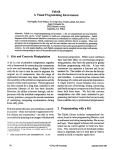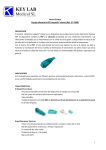Download as a PDF
Transcript
Authoring Graphics-Rich and Interactive Documents in CGLIB – A Constraint-based Graphics Library 1 Neng-Fa Zhou CUNY Brooklyn College & Graduate Center 2900 Bedford Ave., New York, NY 11210 [email protected] http://www.sci.brooklyn.cuny.edu/~zhou ABSTRACT CGLIB is a high-level graphics library for B-Prolog, a constraint logic programming system. The library provides primitives for creating and manipulating graphical objects and a set of constraints including non-overlap, grid, table, and tree constraints that facilitates the specification of the layouts of objects. The library adopts a construct called action rules available in B-Prolog for creating agents and programming interactions among agents or between agents and the user. The library is a fully working system implemented in B-Prolog, Java and C. It can be used in many areas such as drawing editors, interactive user interfaces, document authoring, animation, information visualization, intelligent agents, and games. The high-level abstraction of the library and the use of constraints and action rules in the specification of layouts and behaviors can significantly enhance the productivity of the development of graphics. We demonstrate through several examples the effectiveness of the library as a tool for developing graphics-rich and interactive user interfaces. General Terms Documentation, Design, Languages. Keywords Programming languages, Constraints, Graphics programming, Graphical user interface design, Agents, Action rules, Prolog. 1. INTRODUCTION The widespread use of window systems has made a graphics package indispensable for any programming languages [9]. Prolog and CLP (Constraint Logic Programming) languages in general are not an exception. Some efforts have been made to introduce graphics programming into CLP. One widely used approach is to 1 This research was supported by grants from PSC CUNY, CUNY Software Institute, and ONR (#N00014-96-1-1057). adopt an external interface with a language that supports graphics programming. For example, JIPL is an interface developed by Kino [8] that bridges Prolog and Java bi-directionally. Any Prolog system that adopts the interface will be able to access the graphics library of Java. This approach is not satisfactory for the following two reasons. First, the programmer has to write code in two languages. This is especially daunting when there are interactions involved. Second, the graphics library in the adopted language, whether it is C, C++, Java, VB, or Tcl/Tk, is at such a low level that it does not match well with a high-level language like Prolog. CLP languages deserve a high-level graphics library that can be used to specify easily the states, layouts, and behaviors of graphical objects. Motivated by the observations, we designed and implemented a high-level and constraint-based graphics library, called CGLIB, for B-Prolog. The library provides primitives on graphical objects and provides various kinds of constraints that facilitate the specification of the layouts of graphical objects. The constraint solver of B-Prolog serves as a general-purpose layout manager that is significantly more flexible than the special-purpose layout managers used in Java and Tcl/Tk. The library adopts a construct called action rules available in B-Prolog for programming interactions. An action rule consists of a pattern for agents, a pattern for events that can activate the agents, and an action the agents carry out when activated. Agents can communicate with each other through logical or global variables. Agents can behave concurrently and sequentially as well. CGLIB is implemented in B-Prolog, Java, and C. CGLIB enables the user to use the Java graphics package without the need to write any code in Java. CGLIB, however, is not just another syntax sugar for Java’s graphics package. It has a significantly higher abstraction level and is much easier to learn and use than Java’s graphics package. One of the distinguishable features of CGLIB is the use of constraints in the specification of layouts. In graphics languages such as PostScript and Tex, the programmer has to specify every single detail about the graphical objects, including their sizes and positions. In languages such as Java and Tcl/Tk, the layout managers help determine the layouts of objects for certain applications, but the layout algorithms lack flexibility and are difficult to learn and use. The use of constraints significantly relieves the burden of the programmers to describe many tedious details about layouts. Another distinguishable feature of CGLIB is its support of action rules for specifying interactions. Action rules can be used to describe and synchronize sophisticated and dynamic behaviors of graphical objects in a simple and straightforward manner. CGLIB can be used in many areas such as drawing editors, interactive user interfaces, document authoring, animation, information visualization, intelligent agents, and games. In this paper, we describe the library and present several sample applications. Familiarity with logic and constraint programming concepts is assumed, but most of the material should be readable for readers who don’t have any programming experience in Prolog or CLP. The reader is referred to [3] for the basics. 2. THE CGLIB 2.1 An Illustrative Example Let us start with the following program: go:cgButton(B), B^text #= “Hello World”, handleButtonClick(B), cgShow(B). handleButtonClick(B), {actionPerformed(B)} => halt. (1) (2) (3) (4) (5) (6) (7) (8) The call cgButton(B) in line (1) creates a button B. The constraint in line (2) binds the text attribute of B to “Hello World”. Line (3) creates an event handler, which will be activated when the button B is clicked. The call cgShow(B) in line 4 packs the button, i.e., determines the size and position of the button, and shows the button in the default window. In our example, nothing is mentioned about the color and font of the text, the size of the button and the position of the button in the window. The system determines the attribute values for us either by using the constraints we provided or by using the default values. The action rule in lines 5-8 defines the event handler handleButtonClick(B). The term enclosed in the pair of braces, actionPerformed(B), is called an event, and the right hand side of the rule, halt, is called an action. When an event actionPerformed(B)is posted, i.e, when the button B is clicked, the program terminates. In general, an action can be any sequence of sub-goals. 2.2 Objects The library supports the creation and manipulation of a rich class of objects including arcs, buttons, check boxes, circles, choices, images, labels, lines, lists, ovals, polygons, rectangles, round rectangles, squares, stars, text areas, text fields, text boxes, and triangles (See Figure 1). For each type of objects, there is a primitive for creating objects of the type. For instance, the call cgButton(B) in our illustrative example creates a button. The primitive can also be used to create a list of objects. For example, the call cgButton([B1,B2,B3]) creates three buttons. Figure 1. Base objects. Each object has a certain number of attributes and each attribute has a name and a domain. The attribute attr of an object O is referred to by the notation O^attr. The more commonly used notation O.attr cannot be used here since the ‘.’ has been used as the constructor for lists in Prolog. Each object has the following attributes: • window: The containing window of the object. • x: The x-coordinate of the top-left corner of the object. • y: The y-coordinate of top-left corner of the object. • width: The width of the object. • height: The height of the object. • color: The color of the object. These attributes are stored explicitly and are called base attributes. In addition to the base attributes, each object also has some derivative attributes that are not stored explicitly but are derived from the base attributes. For example, there is a derivative attribute called centerX in every object. When centerX of an object O is accessed, the system replaces O^centerX with a variable, say V, and generates a constraint V #= O^x+O^width//2 which forces V to be the central x-coordinate of O. Each object type may also have some specific attributes in addition to the base and their derivative attributes. For example, a line has the following attributes: • x1,y1,x2,y2: coordinates of the two ends. • thickness: thickness of the line. • arrow1: has an arrow at the first end if 1. • arrow2: has an arrow at the second end if 1. In addition to objects listed in Figure 1, there are also primitives for creating menus, dialogs, and non-visible objects such as colors, fonts, points, and dimensions. Non-visible objects serve as attribute values of visible objects. The table constraint cgTable(L) is not as restrictive as the grid constraint. It forces objects to be placed in a tabular form where each row or each column may have a different size. The tree constraint is useful for arranging components into tree structures. A tree constraint takes the following form: cgTree(Tree,Type,DisX,DisY,Centered) where • Tree is a term in the form node(Node,Children) where Node is a graphical component and Children is a list of sub-trees in the same form as Tree. • Type indicates how the tree grows. It can be one of the following: top_down, left_right, bottom_up, and right_left. • Centered: The value can be either centered or itemized. The value centered means that the root of each sub-tree is placed in the middle of its children, and itemized means that the children are itemized. • DisX is the x-distance between two leaves or the xdistance between a root and its children depending on the type of the tree. • DisY is the y-distance between two leaves or the ydistance between a root and its children depending on the type of the tree. 2.3 Constraints A constraint is a relation among objects. For instance, the constraint O1^x+O1^width//2 #= O2^x ensures that the x-coordinate of O2 is equal to the central xcoordinate of O1. Here the operator // denotes division on integers, and the operator #= denotes the equality constraint. A simpler way to write the constraint is O1^centerX#=O2^x In addition to equality (#=), disequality (#\=), and inequality (#>,#>=,#<,#=<) constraints that are already available in BProlog, the constraint library also contains many symbolic constraints that restrict the layout of objects without accessing their attributes explicitly. These constraints include relative positioning, same property, not-overlap, grid, table, and tree constraints. In addition to mandatory constraints, CGLIB also supports limited preferential constraints. For example, the constraint O^preferredWidth #= 100 tells the constraint solver that the preferable width of O is 100 pixels. A positioning constraint specifies the relative positions of objects. For instance, the constraint cgInside(O1,O2) ensures that O1 is located inside O2. A same property constraint forces a list of objects to have the same value for an attribute. For instance, the constraint cgSame([O1,O2,O3],size) ensures that the three objects O1, O2, and O3 are all of the same size. The notoverlap constraint cgNotOverlap(L) ensures that no two objects in the list L overlap each other. The grid and table constraints are very powerful and flexible for laying out objects in tabular forms. The grid constraint cgGrid(L,PadX,PadY) enforces objects in L to be placed on a grid board, where L is a list of lists of objects or a twodimensional array of objects, and PadX and PadY specify the gap between cells. Cells on a grid board are of the same size. Each object in L occupies the corresponding cell on the board. Objects in L can occur multiple times. In that case, the object will cover all the corresponding cells. For instance, let S1,S2,S3,S4, and S5 be the dominos that contain, respectively, 1, 2, 3, 4, and 5 circles. The following is a grid constraint that determines the layout of the dominos shown in Figure 2. cgGrid([[_, S1,_], [S2,S3,S4], [_,S5,_]]) There is no gap between cells. Figure 2. A layout created by using grid constraints. 2.4 Event Handling CGLIB adopts a construct, called action rules, from B-Prolog for programming interactions. An action rule takes the following form: Agent ConditionSeq {Event} => ActionSeq where Agent is an atomic formula that represents a pattern for agents, ConditionSeq is a sequence of conditions on the agents, Event is a pattern for events that can activate the agents, and ActionSeq is a sequence of actions the agents perform when activated. In contrast to Prolog where unification is used to select applicable clauses, matching is used to select applicable action rules for an agent. All conditions on the left-hand side must be in-line and cannot bind variables in Agent. Example conditions include X=Y, X>Y, arg(N,T,A), and functor(T,F,N). There are a set of built-in events for programming constraint propagators [ZHOU98] and interactive user interfaces. For example, ins(X) is an event that is posted when the variable X is instantiated, actionPerformed(O) is posted when O is clicked if O is a button or when O is selected if O is a menu item. Events are posted in most cases by built-ins, but a user’s program can also post events by using the primitive post(Event). Recall the action rule in our illustrative example: handleButtonClick(B), {actionPerformed(B)} => halt. There is no condition specified on the agent handleButtonClick(B). When an event actionPerformed(B)is posted, the action halt will be executed, which terminates the execution. For some events, the event source does not tell all the information about the event. For example, when a mouse is clicked on a window or a key is typed while a window has the focus, the window cannot know where the mouse click occurred or which key was typed. An event can have a second argument that carries the information. For example, handleMouseEvent(Win), {mousePressed(Win,E)} => E^x #= X, E^y #= Y, write(‘mouse pressed at’), write((X,Y)). The term E is called an event object. Each type of event objects has certain number of attributes. A mouse event, for example, has two attributes named x and y that tell where the mouse event occured. There is no primitive for killing agents. For an agent, if the condition of an action rule in its definition is not satisfied, the next alternative rule will be tried. If that rule does not contain an event, then the agent will be killed automatically after the action is executed. For example, handleButtonClick(B,Flag),var(Flag), {actionPerformed(B)} => Flag=1. handleButtonClick(B,Flag) => true. When the button B is clicked the first time, Flag is bound to 1. On the second time, the first rule becomes inapplicable because the condition var(Flag) fails. The agent haddleButtonClick(B,Flag)disappears after the second rule is applied to it. Notice that the second rule is necessary here. Without it, the agent would fail when the button B is clicked the second time. An agent can be defined by multiple action rules, but the second rule will be tried only after the condition of the first one fails. Therefore, in the following definition, handleButtonClick(B), {actionPerformed(B)} => p(B). handleButtonClick(B), {actionPerformed(B)} => q(B). the second rule will never be tried since the condition for the first rule always succeeds. To let both of the actions p(B) and q(B) be executed when B is clicked, one has to either put them into one rule or create two agents, one executing p(B) and the other executing q(B) when the button is clicked. Each rule can handle one event. To handle multiple events on a component, one has to create one agent for each of the events. Each time when an event is posted, all the agents that are waiting for the event will be activated. If there are multiple agents waiting for an event, then the agent generated first will be activated first. 2.5 Synchronization At the entrance of each predicate, the event queue is checked. If it is not empty, the current predicate will be interrupted and the agents waiting for the events will be activated. The interrupted computation is resumed after the events are handled. Because agents can be interrupted further by other events, the order in which agents are executed is usually unpredictable. Agents can communicate with each other through logic or global variables. An agent can be delayed until a variable is instantiated, or an argument of a structure is set to certain value, or a global variable is set to certain value. Certain computations are uninterruptible. For example, it may cause inconsistency in the system when a predicate that updates shared data is interrupted or when unexpected inputs are entered. For this purpose, CGLIB provides a primitive, called critical_region(Call), which is equivalent to Call but the execution is never interrupted by user’s intervention. 2.6 Packing and Showing Objects The primitive cgShow(O) shows O, and the primitive cgPack(O) packs O and determines the attribute values of O, where O can be one object or a list of objects. When showing an object O, the primitive cgShow(O) calls cgPack(O) automatically to determine the attribute values of O. If O has already been shown before, the primitive will clean up the previous image of O automatically. The bindings of the attributes of O made by cgPack(O) will be lost upon backtracking. Just like the read and write predicates in Prolog, however, cgShow(O) cannot be undone upon backtracking and the graphical objects displayed by the call will not disappear after the execution backtracks over the call. This may result in inconsistencies between graphical objects and their visual appearances. To keep the visual appearances up-to-date, the user has to call cgShow(O) after the state of O changes. The primitive cgShow(O) calls cgPack(O)to pack O before showing it. One may wonder, if cgShow(O) packs O automatically, why do we need cgPack(O). cgPack is provided to let the programmers have more control over the order in which objects are packed. Packing is an NP-hard problem in general and may take a long time if objects are not packed in an appropriate order. It is always a good practice to determine the layout areas for objects before fixing the objects. For instance, recall the dominos shown in Figure 2. It is fast to first pack the squares and then pack the circles inside the squares. 2.7 Altering and Moving Objects A special operator, #:=, is provided to update the attributes of objects. Let O be an object, Attr be an attribute, the following call resets the attribute value to NewValue: O^Attr #:= NewValue The update is destructive and is not undone upon backtracking. The library also provides primitives for scaling, resizing and moving objects. The primitive cgScale(O,F) scales the object or list of objects O by the factor F. The primitive cgResize(O,Width,Height) resizes the object or list of objects O such that the object or list of objects can be covered by a rectangle of the size Width by Height. The primitive cgMove(O,X,Y) moves the object or list of objects O to the position <X,Y>, which will become the new top-left corner of O. These primitives are implemented by using the update operator and the updates are destructive. 3. SAMPLE APPLICATIONS We present six sample applications in this section. Due to the limit on space, only part of the code will be given. The full sources are available from www.probp.com/examples.htm. The examples to be described here are mostly illustrative. The reader can find more examples on the web site. 3.1 Drawing Flags Figure 3 shows six flags drawn by using the CGLIB. The six flags and the labels are laid out in a tabular form. Each flag is composed of several components whose sizes are in certain proportions and whose relative positions are constrained properly. For example, the Antigua flag is composed of a red rectangle, a black triangle, a yellow 16-pointed star, a blue triangle and a white triangle. The USA flag is composed of 50 white 5-pointed stars laid out on a blue background and seven red strips on a white background. Two grid constraints are sufficient for restricting the positions of the stars. The order in which components are shown is very important. When two components overlap, the component shown later will overwrite the one shown earlier. So, for the Antigua flag, the red rectangle must be shown first and the white triangle must be shown last. 2.8 Animation To construct animations, we not only need to construct the static images but also need to decide the order in which the images are rendered and the rate at which changes of images take place. It is possible to suspend the system for a certain period of time. The cgSleep(Time) is introduced for this purpose. While the system is be suspended, no events will be handled. The following example displays a circle in an animated fashion with the color changing from red to black: animateCircle:Colors=[red,pink,yellow,blue,black], cgCircle(C), C^width #= 100, member(Color,Colors), C^color #= Color, cgShow(C), cgSleep(100),fail. 2.9 Generating Java Applets There are demands for images and animations that can be embedded into Web documents. In CGLIB, it is possible to record images into a Java applet. The call cgStartRecord(File) starts and the primitive cgEndRecord ends recording. For example, the following program generates a Java applet named circle.java that animates the color-changing circle: go:cgStartRecord(circle), (animateCircle ; cgStopRecord). Generated Java programs are standalone. Therefore, they can show static and dynamic images but cannot handle interactions. Figure 3. Drawing flags. 3.2 Drawing Trees The constraint cgTree can be used to draw many different kinds of trees. Figure 4 shows a complete binary tree. The constraint cgTree(Tree,top_down,0,10,centered) is used to determine the layout, where Tree is a term that represents the nodes and the parent-children relation, top_down means that each root is located above its children, 0 means that the x-distance between any two leaves is at least 0 pixel, 10 means that the ydistance between a node and its children is 10 pixels, and the last argument centered means that the root of any sub-tree is centered with respect to its children. Figure is a presentation of the Java AWT’s class hierarchy. Each node is a text box. The nodes run from left to right and are connected by horizontal and vertical lines. The positions for the lines depend on those of the nodes. So, it is important to pack the nodes before the lines. where Display is the text field, Acc is the accumulated result, Op is the operator to be applied next, and OnDisplay tells whether the number on display is a result or an operand. Figure 4. A complete binary tree. cgGrid([[Bc,Bdiv,Bmul,Bsub], [B7,B8, B9, Badd], [B4,B5, B6, Badd], [B1,B2, B3, Beq], [B0,B0, Bdot,Beq]],1,1), Figure 6. A calcualtor and the constraint on the layout. Prolog is not an object-oriented language, but this does not prevent us from writing programs in the object-oriented style. A graphical user interface usually generates many handlers each of which carrries the objects it manipulates when activated. In the calculator, there is an event handler, defined as follows, for each key on the keyboard. keyInput(Key,Cal), {actionPerformed(Key)} => Key^text #= KeyLab, process(KeyLab,Cal). Figure 5. The hierarchy of Java AWT's classes. 3.3 Building a Calculator In this example, we consider how to build a working calculator with the interface as depicted in Figure 6. The calculator consists of a display and a keyboard. The display is a text field, which is a base component. The keyboard consists of several keys. The layout of the keys are specified by the grid constraint as given in Figure 6. This example illustrates a nice feature of the grid constraint: a component can occupy multiple grid squares. In this example, the keys labeled “=” (Beq), “+” (Badd), and “0” (B0) are twice as big as the other keys. To carry out calculation, the calculator has to memorize the accumulated result and the operator to be applied. After each operation is applied, the display should show the current result. When the user continues to type the next operand, the display should turn to show the operand. For this purpose, the calculator should also memorize whether the number on display is a result or an operand. We use a structure to represent all the information that has to be memorized: cal(Display, Acc, Op, OnDisplay) The handler takes the object Cal and updates it when activated1. The predicate process(KeyLab,Cal) processes a click of the button labeled KeyLab . Different actions are taken according to the types of keys. For example, when a digit key is clicked, if the number on display is a result, then the calculator cleans the display and shows the digit as part of the next operand; if the number on display is an operand, then the calculator appends the digit to the end of the operand. 3.4 Animating the Towers of Hanoi An animation is a sequence of frames of objects that change along a time line. Animation is better than static graphics for presenting many kinds of data because of its dynamic nature. We consider how to develop an animator for the Towers of Hanoi. Figure 7 shows the interface. 1 B-Prolog provides a built-in called setarg for updating structures. The built-in setarg(I,T,NewA) sets the Ith argument of the structure T to NewA. This predicate makes it possible to update a structure without making a copy of it. This predicate is not in the ISO standard , but many Prolog systems support it. The animator is driven by events. When the start button is clicked, the animator first finds a plan and then turns to execute it. The following is the code for the executor: executePlan(HW,Plan), HW=hw(CP,Disks,Poles,Table), CP=cp(IS,IR,Reset,Start,Pause, Resume,wait,EventVar), {event(EventVar)} => true. Figure 7. Animating the Towers of Hanoi. The interface of the animator is made of two parts. The first part is a control panel that consists of several buttons and two text fields, and the second part is a panel that shows a table, three poles, and several disks. The number of disks and the animation rate can be input through the text fields in the control panel. We use a structure of the following form to represent the control panel: cp(InputSize,InputRate,Reset,Start,Pause, Resume,Status,EventVar) where InputSize and InputRate are two text fields, the four arguments following the text fields are control buttons, and the argument Status denotes the status of the animator which can be one of the following: run meaning the disks are moving, wait meaning that the animator is waiting for the user to press the Resume button, dead meaning that the animator has been killed. The last argument EventVar is an event variable used to notify the animator when the status changes. The predicate for updating the status is as follows: updateStatus(CP,NewStatus):getEventVar(CP,EventVar), setarg(7,CP,NewStatus), post(event(EventVar)). The call getEventVar(CP,EventVar) gets the event variable from the control panel and the call post posts an event event(EventVar) which in turn will activate the plan executor (see below). executePlan(CP,HW,[Step|Plan]), CP=cp(IS,IR,Reset,Start,Pause, Resume,run,EventVar) => executeStep(HW,Step), getSleepTime(CP,Time), cgSleep(Time), executePlan(CP,HW,Plan). executePlan(CP,HW,_) => true. The call executePlan(HW,Plan)is delayed when the status is wait. As we saw before, when the status is updated an event event(EventVar) is posted, which will activate the plan executor. If the status is run, the next rule will be tried. The call executeStep(HW,Step) moves the disk as required in Step, the call getSleepTime(CP,Time)gets the sleeping time from the control panel, and cgSleep(Time) lets the animator sleep for Time milliseconds before it executes the rest of the steps in the plan. Notice getEventVar(CP,EventVar) cannot be used in the guard of the first action rule to get the event variable from the control panel since getEventVar is a user-defined predicate and no non-inline calls are allowed in guards. 3.5 Demonstrating a Geometry Theorem on Quadrilaterals This program demonstrates the following geometry theorem on quadrilaterals: The quadrilateral formed by the four edges that connect the middle points of the edges of another quadrilateral is always a parallelogram. Figure 8 shows two snapshots. The user can move any point of the outer quadrilateral by dragging it. Wherever the outer point moves, the four points of the inner quadrilateral always stay at the middle points of the four edges of the outer quadrilateral. This example is taken from [1]. At a certain time, only a part of the components in the control panel are enabled. In the beginning before the animator is started, the Pause and Resume are disabled. After the animator is started, the Pause button becomes enabled, but the Start button and the two text fields become disabled. The Resume button is enabled only after Pause is pressed and the animator is in waiting state. There is an event handler for each control button. All the event handlers share the object: hw(ControlPanel,Disks,Poles,Table) where Disks is a list of disks, Poles is a list of the three poles, and Table is a rectangle. Disks and Poles are lists of rectangles. When a disk is moved from one pole to another, the position of the disk is updated. From beginning to end, the positions of the poles and the table remain unchanged. Figure 8. Demonstrating a geometry theorem. The program generates and shows two quadrilaterals. It also generates three agents that handle mouse events and maintain the constraints. Let Q be the outer and P be the inner quadrilaterals. The agent handleMouseDown is triggered when the mouse is pressed. It detects whether a point of Q is selected. The agent handleMouseUp is triggered when the mouse is released. It deselects the selected point if any. The agent handleMouseDrag is activated when a point is dragged. If the mouse drag occurs while a point is selected, the agent moves the point and re-computes Q’s points. The three agents are defined in the following: handleMouseDown(Win,O), {mousePressed(Win,E)} => E^x #= X, E^y #= Y, selectPoint(X,Y,O). outgoing and incoming arrows of the box will move automatically. Whenever the user deletes a box, all the arrows that have ends on it will be deleted automatically. (1) (2) (3) (4) handleMouseUp(Win,O), (5) {mouseReleased(Win,E)} => (6) deselectPoint(O). (7) handleMouseDrag(Win,O), {mouseDragged(Win,E)} => (selectedPoint(O,I) -> E^x #= X, E^y #= Y, updatePoint(O,I,X,Y), recomputeP(O); true). (8) (9) (10) (11) (12) (13) (14) (15) All of the three agents share the window Win and an object O that is a Prolog term of the following structure: Figure 9. A box-and-arrow editor. The tool panel contains four user-built buttons laid out in a column. A table constraint is used to specify the layout. To ensure that the arrow and the delete buttons are sufficiently apart from each other, we use a rectangle as a pad between these two buttons. Let L, A, D, and Q be the four buttons and Pad be the pad, then the constraint for the buttons can be written as follows: quadrilaterals(Q,P,Selected) cgTable([[L],[A],[Pad],[D],[Q]],0,5) where Q and P are two polygons, and Selected is the index of the selected point. Selected is –1 when no point of Q is selected. The predicate selectPoint(X,Y,O) in line (4) sets Selected to I if the Ith point of Q is close enough to <X,Y>. The predicate deselectPoint(O) in line (7) sets Selected to –1. The predicate selectedPoint(O,I) in line (7) succeeds if I is the selected point. The predicate updatePoint(O,I,X,Y)in line (13) updates the Ith point of Q to <X,Y>, which is defined as follows: updatePoint(O,I,X,Y):O=quadrilaterals(Q,P,Selected), Q^xs(I) #:= X, Q^ys(I) #:= Y. The notation Q^xs(I) refers to the Ith element of the attribute xs of O, which is an array. The predicate recomputeP(O) in line (14) re-computes the points of the quadrilateral P such that the points remain at the middles of the edges of Q. After the attributes of an object are updated, it is drawn again. When drawing an object that is already on a window, the system automatically cleans up the object before re-drawing it. 3.6 A Box-and-Arrow Editor As the last example, we consider how to develop a box-and-arrow editor as shown in Figure 9. The interface consists of a tool panel and a drawing area. The user can add text boxes to the drawing area and add arrows to connect boxes. For each arrow that connects two boxes, the two ends always reside in the centers of the two boxes. Wherever the user moves a box, the ends of all the There are five rows in the tabular form and there is a 5-pixel space between each two rows. The drawing area is a rectangle located to the right of the tool panel. A Prolog object of the following form is used to keep track of the status of the editor: ba(Win,Area,L,A,D,Q,X,Y,Selected,Bs,As) where • • • • • • • Win is the enclosing window Area is the drawing area L, A, D, and Q are the four buttons X and Y indicate the position of the last mouse click Selected is the selected component. It is nil in the beginning indicating that nothing has been selected. Bs is the list of boxes in the drawing area As is the list of arrows that have been created. For each arrow, in addition to the arrow itself the two boxes connected by the arrow are also memorized. The editor behaves in an event-driven fashion. It creates the initial interface and creates several event handlers all of which take this object. There are handlers for handling mouse presses, keystrokes, mouse drags, window resizing, etc. The following is the action rule that defines the handler for mouse presses: handleMousePress(BA), BA=ba(Win,Area,L,A,D,Q, _X,_Y,Selected,Bs,As), {mousePressed(Win,E)} => E^x #= X, E^y #= Y, handleMousePress(BA,X,Y). The action of the handler depends on the current status of the editor. For example, if a mouse press occurs in the drawing area while Selected is the label button, then the editor is ready to receive a new text box. This action is described as follows: handleMousePress(BA,X,Y):BA=ba(Win,Area,L,A,D,Q, _X,_Y,L,Bs,As), % L selected inside(X,Y,Area),!, setPosistion(BA,X,Y), setSelected(BA,newLabel(_)). Where setPosition updates the X and Y arguments and setSelected updates the Selected argument of BA. The handler for keystrokes, which is defined below, is ready to receive the input characters after this action, i.e., after newLabel(Lab) becomes selected. handleKeyStroke(BA) BA=ba(Win,Area,L,A,D,Q, _X,_Y,Selected,Bs,As), {keyTyped(Win,E)} => E^char #= Char, char_code(Char,Code), (Selected=newLabel(Lab)-> attach(Code,Lab);true). The handler adds the code of the typed character to the end of the list Lab. If the mouse is pressed while Selected is newLabel(Lab), then the editor creates a box with Lab as its text and shows it. Rules for adding arrows work as follows. When a box Box1 is clicked while Selected is the arrow button, then arrowStart(Box1) becomes the newly selected component. If another box Box2 is clicked after this, the editor will create an arrow that goes from Box1 to Box2. It also records the arrow and the two connected boxes. The rule for deleting components is very simple. If Selected is a component (a box or an arrow) when the delete button or the DEL key is pressed, then the component will be deleted. If the component is a box, then all the arrows attached to it will be deleted as well. The rule for moving boxes works as follows. When a mouse-drag event occurs while Selected is a box, the editor updates the position of the box and also updates the arrows attached to the box. 4. IMPLEMENTATION AND EXPERIENCE CGLIB works with B-Prolog Version 6.0 [13, 14, 15]. CGLIB was implemented in three languages: 4500 lines of code in BProlog, 3000 lines of code in Java and several hundreds of lines of code in C. The B-Prolog part is responsible for creating objects and solving constraints. The Java part handles drawing requests from the B-Prolog part and manages graphical objects. The C part is responsible for delegating Java events to B-Prolog. Efforts were made to keep the modifications on the B-Prolog system as minor as possible. For example, existing data structures of B-Prolog are used to represent graphical objects. Because of this, the garbage collector is kept untouched. Action rules were designed originally for programming constraint propagators [14]. Because of the lightness of constraint propagators, B-Prolog has successfully sustained applications that have millions of propagators running co-routinely. Our experience tells that action rules serve very well as a language for programming event handlers. This is not a surprise if the similarity between constraint propagators and event handlers is considered. In B-Prolog, constraints are compiled into specialized propagators that maintain the consistency of the constraints and therefore constraint propagation can be done very fast. Just as for solving constraint satisfaction problems in general, the heuristics for ordering variables is of prominent importance in packing objects. Our system determines the sizes of objects before determining their positions. When determining the sizes of objects, it prefers possibly small objects to large ones, and when determining the positions of objects, it selects largest objects first. This heuristics demonstrates very good performance. We have developed around 50 application programs including medium sized ones. For none of the programs does constraint solving take longer than 100 milliseconds on an 850kHz PC. For most programs, processing drawing requests takes more time than packing objects. 5. RELATED WORK Graphics programming has received a tremendous attention as witnessed by the coverage of the Java’s graphics package in textbooks. Various languages and tools have been developed for creating graphical user interfaces [9]. Object-Oriented Programming (OOP) offers a structured representation of graphical objects. Even before OOP was envisioned, OOP concepts such as class and instance had been used in Sketchpad, the drawing system developed by Sutherland [11]. Currently, all popular OOP languages such as C++, Java, Smalltalk and CLOS come with some graphics packages. Although OOP provides a module scheme for graphical objects, the control part of objects has to be described procedurally. The programmers have to maintain the relationship between the internal data structures of objects and their visual representation. Elliott and Hudak [5, 6] have developed a graphics library for the functional language Haskell. The library consists of new data types and functions for representing time, objects, events, and behaviors. The library facilitates the composition of new objects from existing ones. In terms of the specification of layouts, however, the functional programming approach is not as powerful as the constraint approach since computation is deterministic and information flow is one directional. Constraints have been used in building graphics for many years. In the Sketchpad system [11], constraints were used to represent the relationships of objects and a relaxation algorithm was used to maintain constraints dynamically. Many researchers have explored this declarative approach to graphics development [1,4,10]. Systems such as ThingLab [1] and Amulet [12] are drawing editors that allow the user to draw graphical objects and impose constraints on their layouts. To help the constraint solvers maintain the consistency of the constraints, the user is usually required to specify what attributes are anchors that do not change. There are constraint libraries developed in Java for developing graphical user interfaces or web documents [2,7]. There are also constraint logic programming systems such as Minerva from IF/Computer developed in Java. These libraries and languages developed in Java do not offer as high a level of abstraction as CGLIB and are neither as efficient as CGLIB in terms of the constraint solving power, but have the advantage that they are Java applets and thus can run on not only servers but also clients. [4] I. Cruz, K. Marroitt, and P.V. Hentenryck: Special Issue on Constraints, Graphics, and Visualization, Eds., Constraints An International Journal, Vol.3, No.1, 1998. 6. CONCLUDING REMARKS [8] JIPL – A Java Interface http://www.kprolog.com/jipl.html. CGLIB is a graphics library based on constraint logic programming that provides both constraints and rules for users to specify sophisticated, dynamic, and interactive graphics. Constraints specify how objects should appear, and action rules are used to program event handlers and agents that maintain the consistency of objects. The library has been employed in a graduate-level course on Declarative Programming and several research projects at CUNY Brooklyn. Our early experience tells that the library is much easier to learn and use than the Java’s graphics package. CGLIB should be improved in the following aspects. First, the class of built-in objects needs to be expanded to include more shapes including three-dimensional ones. Second, a mechanism should be provided to allow the users to create their own object types for which the notation O^attr can be used. Third, the performance should be improved further for not only constraint solving but also graphics rendering. 7. REFERENCES [1] Alan Borning, The Programming Language Aspects of ThingLab, a Constraint-Oriented Simulation Laboratory, ACM Transactions on Programming Languages and Systems, Vol.3, 353-387, 1981. [2] A. Borning, R. Lin, and K. Marriott: Constraint-Based Document Layout for the Web, ACM Multimedia Systems Journal, 2000. [3] J. Cohen, Constraint logic programming languages, CACM, No. 7, pp.52-68, 1990. . [5] C. Elliott and P. Hudak: Functional Reactive Animation, Proc. of ACM SIGPLAN International Conference on Functional Programming, 1997. [6] Paul Hudak, The Haskell School of Expression – Learning Functional Programming Through Multimedia, Cambridge University Press, 2000. [7] S. Hudson and I. Smith: SubArctic UI Toolkit User’s Manual, Georgia Institute of Technology, 1996. http://www.cc.gatech.edu/gvu/ui/sub_arctic/. for Prolog, [9] Brad A. Myers, ed.: Languages for Developing User Interfaces, Janes and Bartlett Publishers, 1992. [10] B.A. Myers, R.C.Miller, R. McDaniel, and A. Ferrency: Easily Adding Animations to Interfaces Using Constraints, Proc. ACM User Interface and Software Technology, 119-128, 1996. [11] Ivan Sutherland, Sketchpad: A Man-Machine Graphical Communication System, IFIPS Proc. of the Spring Joint Computer Conference, 1963. [12] B.V. Zanden and B.A. Myers, Demonstrational and Constraint-Based Techniques for Pictorially Specifying Application Objects and Behaviors, ACM Transactions on Computer-Human Interaction, 2(4):308-356, 1995. [13] Neng-Fa Zhou, Parameter Passing and Control Stack Management in Prolog Implementation Revisited, ACM Transactions on Programming Languages and Systems, 18(6), 752-779, 1996. [14] Neng-Fa Zhou: Programming Constraint Propagators in Action Rules, submitted, preliminary version appears in Proc. Joint International Conference and Symposium on Logic Programming, JICSLP, 70-84, 1998. [15] Neng-Fa Zhou: B-Prolog User’s Manual, CUNY Brooklyn & Kyushu Institute of Technology, 1994-2001, http://www.probp.com













